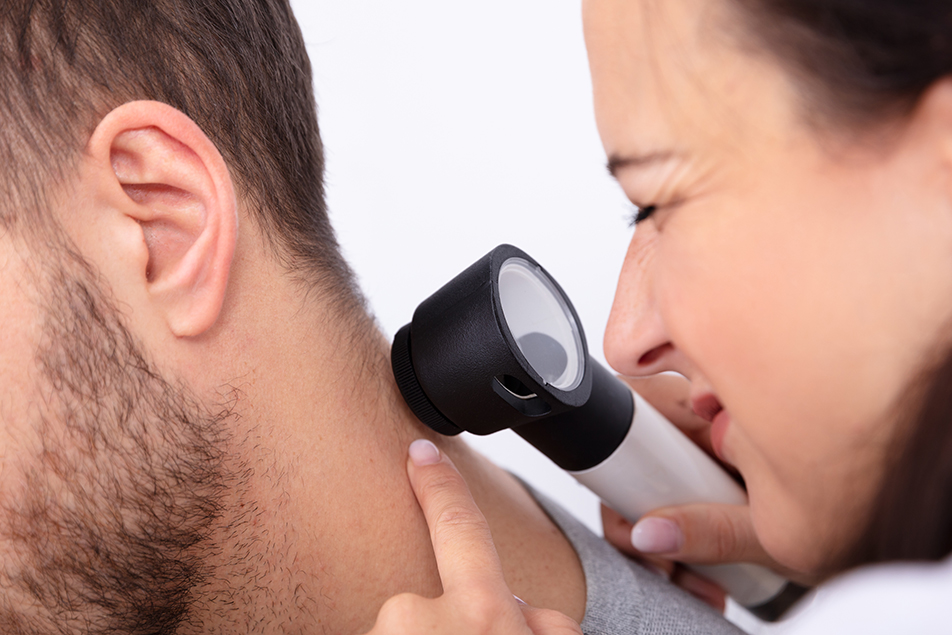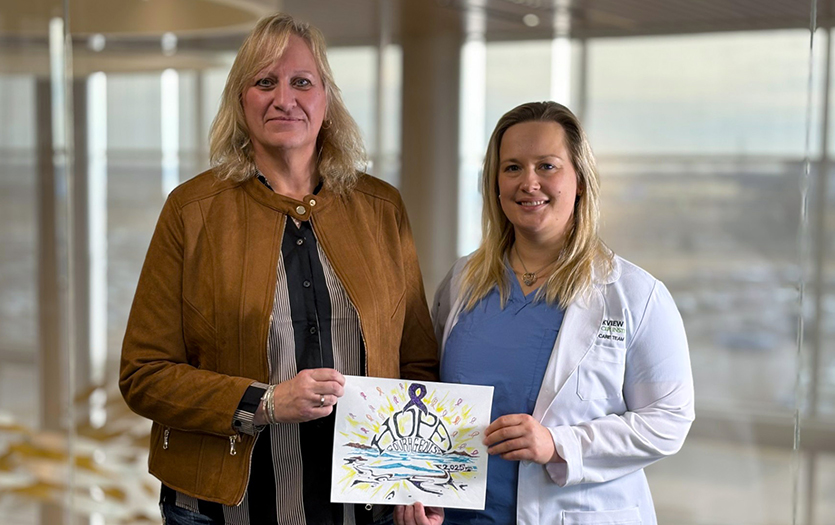.jpg)
This post was written by Robert Bednarek, MD, PPG – Oncology.
Unfortunately, skin cancer, in general, is an epidemic with incident rates that continue to increase. We tend to assume all cases are melanoma because it is the most familiar, but it’s less common compared to basal cell carcinoma (BCC) or squamous cell carcinoma (SCC). BCC and SCC are actually the two most common nonmelanoma forms of skin cancer that we encounter. In fact, more people are diagnosed with skin cancer, particularly BCC and SCC, than all the other cancers combined in the U.S.
In 2006, there were an estimated 3.5 million cases of nonmelanoma skin cancer, which included both basal and squamous cell carcinomas. In 2012, there were 5.4 million cases that were treated and 4.3 million of those cases were BCC. To put that into perspective, about one in five, or 20% of Americans will develop skin cancer by the age of 70. These numbers help illustrate the steep increase in incidents that we're seeing each year and how prevalent these types of skin cancers are.
Basal cell carcinoma
Compared to melanoma, BCC rarely spreads to other places on the body. However, it can be locally destructive, causing loss of function to the surrounding structures. For example, it can form on the eyelids, causing deformities and issues for people trying to form tears or close their eyes properly. You can also have local comorbidities with BCC, like pain and persistent bleeding at the cancer site.
Prevalence
Basal cell carcinoma is the most common form of nonmelanoma skin cancer. Remember that statistic I gave you? One in five or 20% of Americans will develop skin cancer by the age of 70 and 80% of that will be BCC. It’s the skin cancer we encounter and see most often. On average, we will diagnose BCC cases 3-10 times per day with most patients not realizing they even have it, which is why it's so important to see a dermatologist for a regular skin check.
Causes
The most common cause of most skin cancer is far and away the result of ultraviolet radiation exposure from the sun or artificial sources. Intermittent intense sunburn and chronic cumulative sun exposure both contribute to the formation of BCC, which is why it’s important to protect yourself with sunscreen or sun-protective clothing. These two options are truly the best preventative measures you can take to decrease your risk of cancer.
There are a few genetic syndromes where we will see basal cell carcinoma more prevalently, but this is more the exception than the rule. Generally, we look at sun exposure as the main culprit in causing basal cell skin cancer.
Signs and symptoms
BCC can present in various ways. Sometimes it can be a bump that a patient was either aware or unaware of, but more commonly it tends to present as a nonhealing sore or ulceration. Patients will often describe it as a pimple that just won’t go away.
Diagnosis
BCC is best diagnosed by a dermatologist since they have expertise in the area. First, they’ll perform an initial exam, then if they have enough suspicion that it could be BCC, they will perform a biopsy.
Generally, we do this via shave removal. We will rarely do a punch or incisional biopsy. Once we take a sample, we will send it off to the pathology lab and they will give us the confirmation that it’s BCC. Then, depending on subtype – some are more aggressive than others – your dermatologist will come up with the best treatment plan for the affected area.
Treatment
There are several different treatment modalities we can use for BCC. Your dermatologist will consider several things. They will look at your treatment plan, whether the BCC is an aggressive or non-aggressive form and where it’s located on the body, such as a high-risk location like on your face, nose or back of the hands, versus a low-risk area, such as your back.
The most common treatments that your dermatologist might perform include local destructive measures like freezing (cryosurgery), ‘scrape and burn’ (curettage followed by electrodesiccation/freezing), surgical excision or a topical chemotherapy cream followed by close supervision to ensure the treatment is working and the skin cancer is responding.
Additionally, there are some exciting options on the horizon including a modality new to Parkview called Mohs Micrographic Surgery. This modality is generally utilized for high-risk areas and more aggressive subtypes of BCC. Mohs surgery is also unique in that it has the highest cure rates for nonmelanoma skin cancer with a 99% cure rate for BCC.

Squamous Cell Carcinoma
SCC is the second most common form of nonmelanoma skin cancer. While SCC is not dissimilar to BCC, it does have a slightly different presentation, although there can be some overlap in appearance between the two. While it’s not as common as BCC, we do see it often and diagnose, on average, 1-5 cases per day, depending on the patient population.
Prevalence
As mentioned, SCC is becoming increasingly more common and, unfortunately, we do tend to worry a little more about SCC than we do BCC because it has a higher chance of spreading to other places of the body. In fact, some studies state that up to 5% of SCC cases have the potential of metastasizing to areas such as lymph nodes and organs, making SCC more dangerous when it comes to skin cancer.
A recent study also suggests that more than twice as many people are dying from SCC compared to melanoma, which is due to the higher incidence rate of SCC. For this reason, skin cancer should never be taken lightly. It’s imperative that you touch base with your dermatologist or an expert in the field to come up with a treatment plan.
Causes
Similar to BCC, SCC is caused by ultraviolet radiation, sun exposure, intermittent intense sunburns as well as chronic cumulative sun exposure. There are also rare genetic syndromes in which SCC becomes more prevalent. SCC can also occur as a result of other underlying causes.
Immunosuppression, for example, can make you more susceptible. Those with chronic lymphocytic leukemia (CLL) or transplant patients are at a higher risk because they're immunosuppressed and are more susceptible to forming SCC. Therefore, we tend to watch these patients very diligently.
Additionally, chronic inflammation and nonhealing wounds can allow SCC to pop up in those locations. You can also get SCC in previously irradiated sites even years after radiation. Certain types of human papillomavirus (HPV) may also contribute to SCC.
Signs and symptoms
There can be some overlap with BCC. Sometimes SCC can present as a non-ulceration or wound, but typically it's a scaly, firm area, bumps or nodules that patients will say just won’t go away.
SCC has a precursor lesion called an actinic keratosis, which can feel like little bits of sandpaper on the skin. These are called precancerous spots and have a chance of evolving into SCC. We can see an overlap between pre-cancer and skin cancer. Generally, dermatologists will try to treat some of the pre-cancer to make sure they don't devolve into skin cancer, or in this case, SCC.
Diagnosis
SCC is diagnosed similarly to BCC. We'll do an initial examination and biopsy, typically a shave removal or a shave biopsy. Sometimes we will also do an incision or excisional biopsy, depending on the size of skin cancer. Then, we'll send that to pathology, and they'll give us the diagnosis. From there, we’ll tailor your treatment based on what the report says.
Treatment
SCC is treated very similarly to BCC. Generally, the first step for both BCC and SCC is surgery. The standard excision is most common for low-risk SCC. For higher-risk SCC cases, we will utilize Mohs surgery, which has a 97% cure rate for SCC cases and will allow us to have marginal control over the affected area.
For more superficial cases, we will use the same modalities as BCC, like scrap and freeze, chemotherapy, immunomodulators and topical chemotherapy creams. It depends on how deep the skin cancer has gone. Deeper areas will require surgical measures like Mohs surgery.
The risk of nonmelanoma cancers
The issue is that most publicity regarding skin cancer is focused on melanoma. Melanoma is one of the scarier skin cancers we see as dermatologists, but BCC and SCC should be taken just as seriously. What it really comes down to is recognizing the signs and symptoms of any form of skin cancer earlier rather than later, giving the skin cancers less time to progress. That’s why it's essential to address any concerns you might have right away.
A warning for patients
Far and away, I tell my patients, especially if they've had skin cancer or even a pre-cancer, to wear sunscreen or some form of sun protection. I always emphasize how important it is that patients be proactive in their skincare to minimize their risk of forming skin cancers because once you’ve been diagnosed with skin cancer, you’re at a higher risk of developing other skin cancers.
So, if there's ever a concerning spot, please see a dermatologist and get it evaluated. It's easy for us to look at it and take a sample, especially if it means catching something that could have been prevented.
Prevention
Sun protection, sun protection, sun protection! I can’t say it enough. Patients have absolute control over this. Now, if you have an underlying genetic syndrome, that's something that's not necessarily in your control, but for most, sun protection is an easy form of prevention.
The American Academy of Dermatology recommends wearing an SPF 30 sunscreen that is broadband and water-resistant. The biggest area I see patients struggle with is reapplication. Applying sunscreen once a day doesn't mean you're covered. When you're directly in the sun, you need to be reapplying every two hours. If you're sweating or in the pool, you need to reapply every 80 minutes, even with your water-resistant sunscreen.
There’s also some nice SPF clothing on the market. This type of clothing can be a great compromise for anyone that might not love the feel or greasiness of sunscreen.
Final thoughts
If you have a concerning spot, please contact your primary care doctor or get in to see a dermatologist. The bottom line is that early prevention and detection are key.



